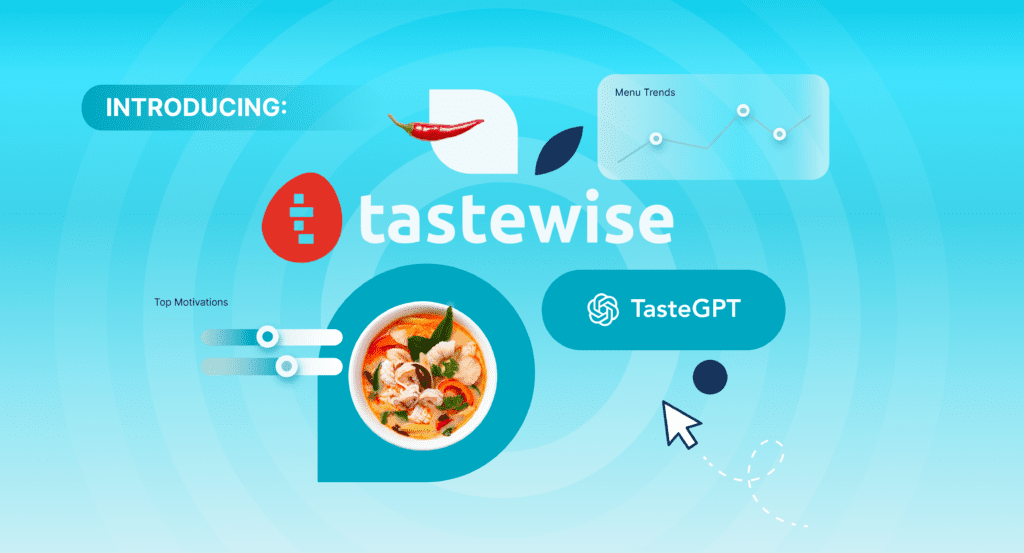Under fake pink cherry blossom, guests sipped House of Suntor cocktails and picked at plates of chicken karaage, prawn gyoza, and cauliflower tempura from a kaitenzushi-style conveyor belt.
This scene unfolded at the London launch of Waitrose’s new Japanese range, Japan Menyū. However, what many attendees didn’t realise is that their food choices played a pivotal role in shaping this innovative supermarket range, and it was all thanks to artificial intelligence (AI).
AI’s Growing Influence in the Food Industry
While AI’s presence in various industries is often met with scepticism and fear, it’s making significant strides in the food industry. According to McKinsey’s 2022 Global Survey on AI, its use has doubled since 2017.
Furthermore, Waitrose, as a premium retailer in the United Kingdom, recognised the potential of AI to gain insight into evolving food trends and meet the expectations of its discerning customers.

A Recipe for Success: Tastewise’s AI Insights and The Power of Social Media
Traditionally, tracking food trends involved laborious manual research, studying menus, and combing through social media. However, companies like Tastewise, an Israeli AI company, are changing the game.
Tastewise’s AI platform collects and analyses vast amounts of data from menus, social media posts, and online recipes, pinpointing emerging food trends. Waitrose used Taste Wise data to make informed decisions about its Japan Menyū range.
Social media plays a pivotal role in this AI-driven culinary revolution. Instagram, for instance, reveals more than just food photos, it provides valuable information about preferences and cooking methods.
Furthermore, hashtags like #fried, #crispy, or #barbecued offer insights into texture and preparation techniques. Also, Pinterest pins indicate an intention to cook, further refining AI’s understanding of consumer behaviour.

De-risking Food Innovation and The Need for Human Guidance
The food industry faces challenges in product development, where the risk of failure is high. By integrating AI insights with their own customer and sales data, companies like Waitrose can de-risk the process. This newfound agility ensures that products align with consumer demands and preferences.
Moreover, AI isn’t infallible, as evidenced by an unfortunate incident at a New Zealand supermarket. Pak’nSave‘s AI-generated meal ideas turned disastrous. The human element is crucial in refining AI-generated concepts, ensuring they align with practicality and safety standards.
The Future with AI: Speed and Precision and AI’s Impact on the Food Industry
Waitrose is also exploring Tastewise’s new AI chatbot, TasteGPT. This technology has the potential to accelerate product development. Chefs can use AI-generated recipes as a starting point, fine-tuning them for mass production. Also, this precision is vital in the culinary world, where even small deviations can yield dramatically different results.
The explosion of social media use has left the food industry, with its bureaucratic product development processes, trailing in its wake. Consumers are moving quicker than retailers on trend prediction.
For example, when Upton used machine learning to research food trends before the 2020 launch of Panku, which today has more than 140 kiosks in Asda stores, several other trends, including bubble tea and CBD (cannabidiol), also jumped out.

AI’s Quirks and the Human Touch
But what about when AI goes wrong, as it did for New Zealand supermarket Pak’nSave when an app designed to generate helpful meal ideas served up recipes for deadly chlorine gas and poison bread sandwiches?
Well, the answer is that this is where the human element is really important. It is vital to treat it as a conversation because sometimes it will throw out a concept that you know is not going to work.
Therefore, you either have to go through the process of having a conversation with the platform to refine it further, constantly asking it questions, which will get it closer and closer to what you want.
Faster, Closer, and Happier Shoppers
Furthermore, Waitrose is also testing Taste Wise’s new AI chatbot TasteGPT. At a recent conference in London, a chef cooked ‘Indian and Mexican fusion tacos’, a concoction that pooled trending cuisines, proteins, and flavours that it had identified.
But rather than feeling threatened by a chatbot that can generate recipes in seconds, the chef sees the potential to develop products faster than the current 12-month average. The process a person goes through to write a recipe is quite extensive because it has to be so precise, and also, if you’re a gram out in a 100g recipe, it’s going to be wildly out by the time you make a tonne of it.

Conclusion
In a world where food trends change faster than ever, AI is helping supermarkets, like Waitrose, stay ahead of the curve. By harnessing the power of artificial intelligence, Waitrose not only meets but exceeds customer expectations, delivering innovation, newness, and excitement to its shoppers.
Furthermore, the marriage of AI’s data-driven insights and human expertise promises to revolutionise the way we experience food, ensuring that our tastes and preferences are met with speed and precision.
Finally, in the ever-evolving culinary landscape, AI is proving to be a vital ingredient for success. This fusion of technology and tradition will result in a mass of happy shoppers, as products hit the shelves faster and closer to when people want them.









